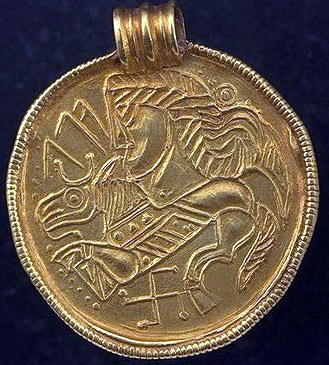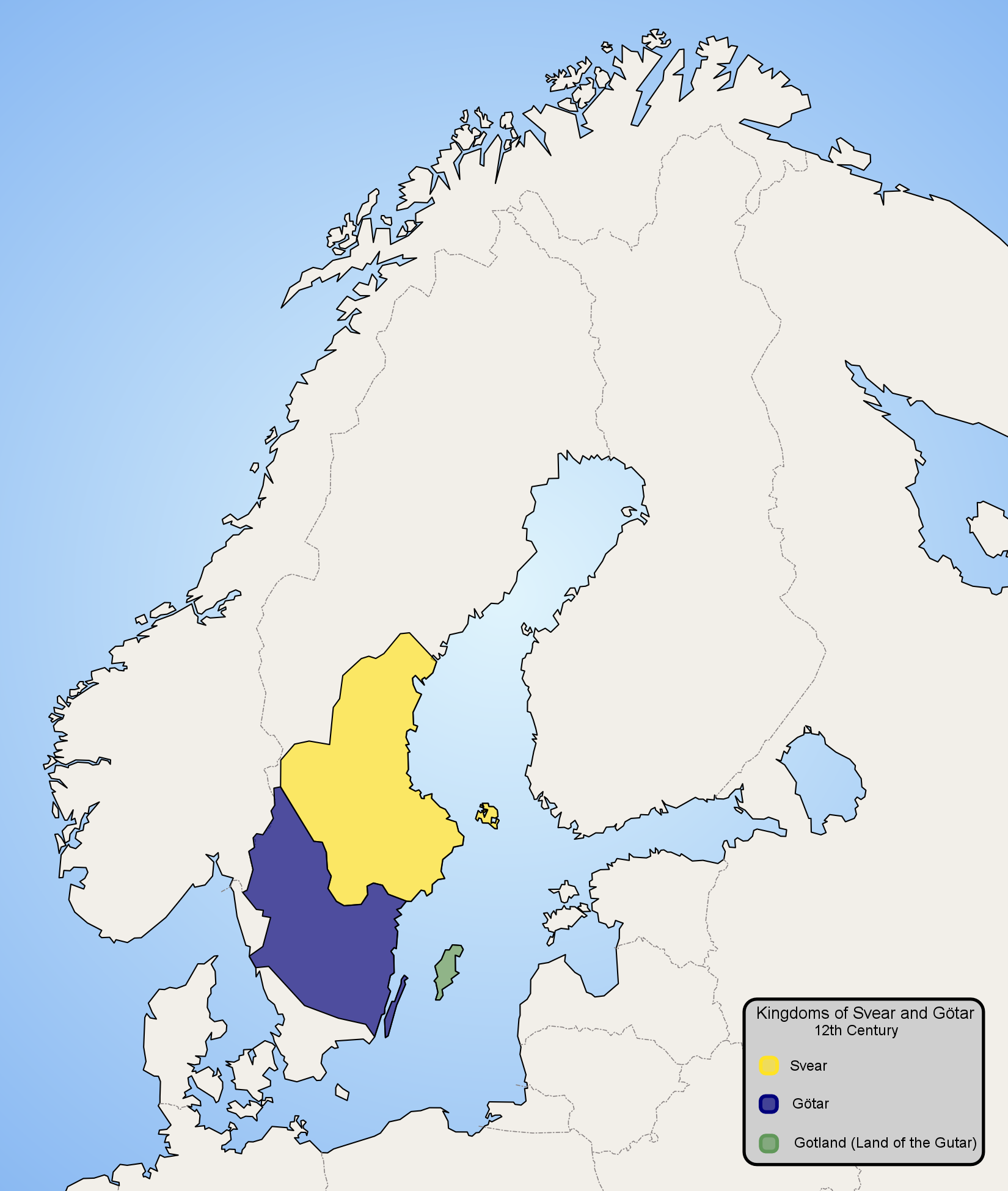|
Kylver Stone
The Kylver stone, listed in the Rundata catalog as runic inscription G 88, is a Swedish runestone which dates from about 400 AD. It is notable for its listing of each of the runes in the Elder Futhark. Description The Kylver stone was found during the excavation of a cemetery near a farm at Kylver, StГҐnga, Gotland in 1903. The stone was a flat limestone rock used to seal a grave and the runic inscription was written on the underside, and could therefore not be read from above. The dating of the stone from 400 CE is based upon the archeological dating of the graves. The Kylver stone was removed from Gotland and brought to the Swedish Museum of National Antiquities in Stockholm where it is on display . The fact that the inscription was on the inside of a cover to a grave has resulted in speculation that it represented a use of the Elder Futhark to pacify the dead man in some manner. However, it has been pointed out that there is nothing in the inscription to support this. In ... [...More Info...] [...Related Items...] OR: [Wikipedia] [Google] [Baidu] |
Wynn
Wynn or wyn (; also spelled wen, Жїynn, and Жїen) is a letter of the Old English alphabet, where it is used to represent the sound . History The letter "W" While the earliest Old English texts represent this phoneme with the digraph , scribes soon borrowed the rune ''wynn'' for this purpose. It remained a standard letter throughout the Anglo-Saxon era, eventually falling out of use (perhaps under the influence of French orthography) during the Middle English period, circa 1300. It was replaced with once again, from which the modern developed. Meaning The denotation of the rune is " joy, bliss" known from the Anglo-Saxon Rune Poems: Miscellaneous It is not continued in the Younger Futhark, but in the Gothic alphabet the letter ''w'' is called , allowing a Proto-Germanic reconstruction of the rune's name as ''*wunjГґ'' "joy". It is one of the two runes (along with Гѕ) to have been borrowed into the English alphabet (or any extension of the Latin alphab ... [...More Info...] [...Related Items...] OR: [Wikipedia] [Google] [Baidu] |
Swedish National Heritage Board
The Swedish National Heritage Board ( sv, Riksantikvarieämbetet; RAÄ) is a Swedish government agency responsible for World Heritage Sites and other national heritage monuments and historical environments. It is governed by the Ministry of Culture. The goals of the agency are to encourage the preservation and protection of historic environments and to promote the respect for and knowledge of historic environments. In order to do this, it tries to ensure that Swedish heritage is accessible to all citizens, to spread information about that heritage, and to "empower heritage as a force in the evolution of a democratic, sustainable society". History 17th and 18th century The National Heritage Board was founded in 1630. On the 20May that year, Johannes Bureus who was a prominent rune researcher and King Gustavus Adolphus' private teacher, was appointed the first ''riksantikvarien'' ("National Antiquarian"). Bureus' teachings had made the king interested in ancient monuments ... [...More Info...] [...Related Items...] OR: [Wikipedia] [Google] [Baidu] |
Vadstena Bracteate
The Vadstena bracteate (Rundata Г–g 178) is a gold C-bracteate found in the earth at Vadstena, Sweden, in 1774.'' Nordisk Familjebok'', Owl Edition, pp. 262-26/ref> Along with the bracteate was a gold ring and a piece of gold sheet: all were nearly melted down by a goldsmith who was stopped by a local clergyman. The bracteate was stolen in 1938 from the Swedish Museum of National Antiquities and has not yet been found. The bracteate is believed to have been made about AD 500. In the middle of the bracteate is a four-legged animal with a man's head above it, and in front of this a bird separated from the other images by a line. This image is commonly associated with the Norse god Odin in bracteate iconography. The bracteate is most famous for containing a full listing of the Elder Futhark runic alphabet. The runes in the futhark are divided by dots into three groups of eight runes which are commonly called an Г¦tt. The entire inscription reads: :tuwatuwa; fuГѕarkgw; hnijГЇpzs; ... [...More Info...] [...Related Items...] OR: [Wikipedia] [Google] [Baidu] |
Runic Magic
There is some evidence that, in addition to being a writing system, runes historically served purposes of magic. This is the case from the earliest epigraphic evidence of the Roman to the Germanic Iron Age, with non-linguistic inscriptions and the ''alu'' word. An '' erilaz'' appears to have been a person versed in runes, including their magic applications. In medieval sources, notably the Poetic Edda, the '' SigrdrГfumГЎl'' mentions "victory runes" to be carved on a sword, "some on the grasp and some on the inlay, and name Tyr twice." In the early modern period and modern history, related folklore and superstition is recorded in the form of the Icelandic magical staves. In the early 20th century, Germanic mysticism coined new forms of "runic magic", some of which were continued or developed further by contemporary adherents of Germanic Neopaganism. Modern systems of runic divination are based on Hermeticism, classical Occultism, and the I Ching. Historical evidence T ... [...More Info...] [...Related Items...] OR: [Wikipedia] [Google] [Baidu] |
List Of Runestones
There are about 3,000 runestones in Scandinavia (out of a total of about 6,000 runic inscriptions). p. 38. The runestones are unevenly distributed in Scandinavia: The majority is found in Sweden, estimated at between 1,700 and 2,500 (depending on definition). Denmark has 250 runestones, and Norway has 50. There are also runestones in other areas reached by the Viking expansion, especially in the British Isles ( Manx runestones, Page, Raymond I. (1995). Runes and Runic Inscriptions: Collected Essays on Anglo-Saxon and Viking Runes'. Parsons, D. (ed.) Woodbridge: Boydell Press, 207–244 England runestones, Scotland and Ireland) and other islands of the North Atlantic (Faroes, Greenland, but not in Iceland), and scattered examples elsewhere (the Berezan' Runestone in Eastern Europe, Pritsak, O. (1987). ''The Origin of Rus'.'' Cambridge, Mass.: Distributed by Harvard University Press for the Harvard Ukrainian Research Institute. Sawyer, Birgit. (2000). The Viking-Age Rune-Stones ... [...More Info...] [...Related Items...] OR: [Wikipedia] [Google] [Baidu] |
Sweden
Sweden, ; fi, Ruotsi; fit, Ruotti; se, Ruoŧŧa; smj, Svierik; sje, Sverji; sju, Sverje; sma, Sveerje or ; yi, שוועדן, Shvedn; rmu, Svedikko; rmf, Sveittiko. formally the Kingdom of Sweden, is a Nordic countries, Nordic country located on the Scandinavian Peninsula in Northern Europe. It borders Norway to the west and north, and Finland to the east. At , Sweden is the largest Nordic country and the List of European countries by area, fifth-largest country in Europe. The Capital city, capital and largest city is Stockholm. Sweden has a population of 10.5 million, and a low population density of ; around 87% of Swedes reside in urban areas in the central and southern half of the country. Sweden’s urban areas together cover 1.5% of its land area. Because the country is so long, ranging from 55th parallel north, 55°N to 69th parallel north, 69°N, the climate of Sweden is diverse. Sweden has been inhabited since Prehistoric Sweden, prehistoric times, . T ... [...More Info...] [...Related Items...] OR: [Wikipedia] [Google] [Baidu] |
Suiones
The Swedes ( sv, svear; Old Norse: ''svГar'') (probably from the PIE reflexive pronominal root * s(w)e, "one's own ribesmen/kinsmen;Bandle, Oskar. 2002. The Nordic languages: an international handbook of the history of the North Germanic languages. 2002. P.391 ang, SwД“on) were a North Germanic tribe who inhabited Svealand ("land of the Swedes") in central Sweden and one of the progenitor groups of modern Swedes, along with Geats and Gutes. They had their tribal centre in Gamla Uppsala. The first author who wrote about the tribe is Tacitus, who in his ''Germania'' from 98 CE mentions the ''Suiones''. They are possibly first mentioned locally by the Kylver Stone in the 4th century. Jordanes, in the 6th century, mentions ''Suehans'' and ''Suetidi''. ''Beowulf'' mentions the Swedes around 1000 A.D. According to early sources such as the sagas, especially ''Heimskringla'', the Swedes were a powerful tribe whose kings claimed descendence from the god Freyr. During the Viking Age ... [...More Info...] [...Related Items...] OR: [Wikipedia] [Google] [Baidu] |
Younger Futhark
The Younger Futhark, also called Scandinavian runes, is a runic alphabet and a reduced form of the Elder Futhark, with only 16 characters, in use from about the 9th century, after a "transitional period" during the 7th and 8th centuries. The reduction, somewhat paradoxically, happened at the same time as phonetic changes that led to a greater number of different phonemes in the spoken language, when Proto-Norse evolved into Old Norse. Also, the writing custom avoided carving the same rune consecutively for the same sound, so the spoken distinction between long and short vowels was lost in writing. Thus, the language included distinct sounds and minimal pairs that were written the same. The Younger Futhark is divided into long-branch (Danish) and short-twig (Swedish and Norwegian) runes; in the 10th century, it was further expanded by the "Hälsinge Runes" or staveless runes. The lifetime of the Younger Futhark corresponds roughly to the Viking Age. Their use declined after ... [...More Info...] [...Related Items...] OR: [Wikipedia] [Google] [Baidu] |
Palindrome
A palindrome is a word, number, phrase, or other sequence of symbols that reads the same backwards as forwards, such as the words ''madam'' or ''racecar'', the date and time ''11/11/11 11:11,'' and the sentence: "A man, a plan, a canal – Panama". The 19-letter Finnish word ''saippuakivikauppias'' (a soapstone vendor), is the longest single-word palindrome in everyday use, while the 12-letter term ''tattarrattat'' (from James Joyce in '' Ulysses'') is the longest in English. The word ''palindrome'' was introduced by English poet and writer Henry Peacham in 1638.Henry Peacham, ''The Truth of our Times Revealed out of One Mans Experience'', 1638p. 123/ref> The concept of a palindrome can be dated to the 3rd-century BCE, although no examples survive; the first physical examples can be dated to the 1st-century CE with the Latin acrostic word square, the Sator Square (contains both word and sentence palindromes), and the 4th-century Greek Byzantine sentence palindrome '' nipson ... [...More Info...] [...Related Items...] OR: [Wikipedia] [Google] [Baidu] |
Г†sir
The Æsir (Old Norse: ) are the gods of the principal pantheon in Norse religion. They include Odin, Frigg, Höðr, Thor, and Baldr. The second Norse pantheon is the Vanir. In Norse mythology, the two pantheons wage war against each other, resulting in a unified pantheon. Unlike the Old English word ''god'' (and the Old Norse word '), Æsir was never converted over to Christian use. Etymology ''Æsir'' is the plural of '' áss'', ''ǫ́ss'' "god". In genitival compounds, it takes the form ', e.g. in ' ("Thor of the Æsir"), besides ' found in : '' ás-brú'' "gods' bridge" (the rainbow), : ' "gods' enclosure", : ' "gods' kin", : ' "gods' leader", : ' "gods' might" (especially of Thor), : ' "divine wrath" etc. : ' "national god" (') is a title of Thor, as is : ' "almighty god", while it is Odin who is "the" '. There is also Old East Norse dialectal : *''ās-ækia'' (OWN: *''áss-ekja''), i.e. "god ride" (Thor riding in his wagon), resulting in the modern Swedish word ... [...More Info...] [...Related Items...] OR: [Wikipedia] [Google] [Baidu] |





